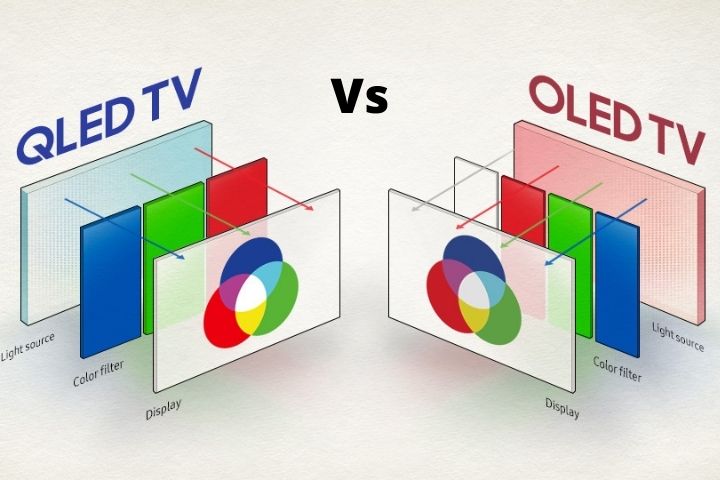What Are The Differences Between OLED And QLED Screens?

Are you willing to buy a new TV ? And If you are probably undecided about the type of panel technology there is, especially between OLED and QLED .Don’t worry, in this article we provide you, what each of these technologies consists of, seeing their differences, and which one is better and which one you should buy.
The two technologies are relatively new, but more and more devices use them.They are quite expensive and in most cases -especially in terms of TV- they are only fit for lucky pockets. However, let’s first see what each of them consists of and then we’ll buy the main parameters of them to discern which of the two technologies is better today.
Here,in this article we’re going to discuss about differences between OLED and QLED
Table of Contents
What Is OLED Technology?
The LCD LED televisions that we have been using, and continue to use today, work with a panel of pixels that need a backlight source (backlight) to illuminate, and in this case this illumination is done through LED diodes. This lighting can also be lateral, hence also EDGE LED televisions, but the fact is that an LED television requires these diodes to illuminate its pixels.
This has a consequence, and that is that since they are always illuminated, the pixels are unable to achieve pure black, this being rather a very dark gray. This limits contrast, reduces viewing angles and displays less vivid, duller colors.
OLED panels work radically differently. These panels are organic, and do not need backlighting because each pixel has the ability to illuminate itself . This has a consequence that is the main advantage of OLEDs compared to traditional LED LCDs: a pure black, and therefore, an almost infinite contrast.
How do they achieve a pure black? Well, because the pixels can be turned off or illuminated individually, so that when there is black in the image, those pixels are directly turned off, resulting in absolute black and infinite contrast .
Colorimetry also benefits in OLEDs, since by not having light pollution from the adjacent pixels, and thanks to the enormous contrast, the colors are more vivid, more saturated and much richer.
What Is QLED Technology?
QLEDs are still an evolution of LED televisions . With this technology, Samsung uses a metallic coating on the nanoparticles that, in effect, increases the brightness and improves the color spectrum, but still requires back or side lighting to illuminate each pixel.
It is true that the color coverage and brightness are slightly increased, but the blacks are not pure and remain rather gray, the contrast is limited and the viewing angles are still around 60% , just like in LED televisions lifelong.
The best thing about QLED is undoubtedly its reproduction of the color spectrum, which is practically 100%. But this is thanks to Quantum Dots, a technology inherited from SONY’s Triluminos and which was created in 2011. Quantum Dots are nanocrystals whose main virtue is that they can emit light by themselves and emit light in more waveforms, thus covering more of the color spectrum.
Quantum Dots make it possible to dispense with the RGB filters and polarizers of the LCD panels, managing to manufacture thinner panels, almost as thin as OLEDs. By removing all these filters, the amount of light received is also increased, hence the increased brightness of the QLEDs.
What Are The Advantages Of QLED Technology?
Brightness
QLED has Higher technology. QLED panels are able to offer more brightness than OLEDs. At this point we have to talk about the nits. The nits is nothing more than the measurement used to refer to the amount of light that a screen is capable of emitting. Therefore, we can now say that QLED panels are capable of reaching 1,500-2,000 nits compared to 800 nits for OLED panels.
Greater Volume Of Color
QLED displays offer a higher color volume. Samsung claims that they can reproduce all color spectra. In addition, they allow the light entering each pixel to be controlled, thereby improving its saturation.
Greater Viewing Angle
QLED technology has a greater angle of view. That means that, no matter where you position yourself to watch TV, you will see it perfectly from any angle. Which is not the case with LED panel televisions.
More Economical
Currently, televisions with QLED technology are cheaper than OLEDs. Although LG sells OLED panels to other Brands such as Panasonic, Sony, Philips, etc. And that means increasing the quantity produced and competition, the price may vary a little. That is why we recommend that you analyze the size and models of each brand well to be able to choose correctly.
Why Are OLEDs Still Better Than QLEDs ?
Although it is true that QLEDs improve the color spectrum and significantly increase the brightness, this does not translate into superior image quality. The truth is that OLED is still a technology that provides better image quality in every way .
Image quality is mainly determined by two factors: colorimetry and contrast. In colorimetry, QLED and OLED are practically the same, but in contrast OLED is immensely superior, and therefore OLED has better image quality.
In some places you will be able to read that the contrast in the QLEDs is higher than the OLEDs when increasing the brightness, but this is not the case, since to increase the brightness in a QLED you must also increase the black level, with which the ratio of Contrast is limited, compared to OLEDs where this ratio is infinite because the black value is 0.
Differences Between OLED And QLED?
The biggest trap that Samsung has made with its QLEDs is precisely the name: QLED is very similar to OLED, so many people will think that it is a similar technology, but as you have seen in this article, this is not the case . It is a very basic and very old marketing tactic, that of passing one thing for another, when in reality it is a very different thing.
The problem is that even Samsung’s older generation TVs show better results than the newer QLEDs. You can see in this video the differences between the Samsung KS9500, from 2015 and that uses FALD technology (left) compared to the Samsung Q9, from 2018:
There is not even the advantage of a lower price, since Samsung has put its QLEDs at the same price as the OLEDs of the competition, so in this case it is ridiculous to buy a QLED and be able to buy an OLED at the same price .
In addition, OLED televisions have dropped in price and no longer have such exorbitant prices as at the beginning, being able to find OLED televisions quite cheap , although obviously, and as high-end products are expensive products for which you have to make an outlay of money. But, if you want to spend the money better spend on an OLED TV.
Criticism of Samsung for adopting this technology, instead of OLED, and the somewhat ridiculous trap of naming it QLED, with the aim of confusing a non-specialized public and making them believe that it is something similar to OLED, has led the company to lose a significant market share in the field of televisions .
This has led the Korean company to resume the manufacture of FALD LED televisions , of which the Samsung Q9FN is a highly recommended model and that greatly improves the image quality of the rest of the QLED televisions in its catalog.
Samsung is still betting on the manufacture of QLED panels. We will see until when, because the marketing trap has not crept in and people are beginning to be very clear that QLED televisions have nothing to do with OLEDs.






